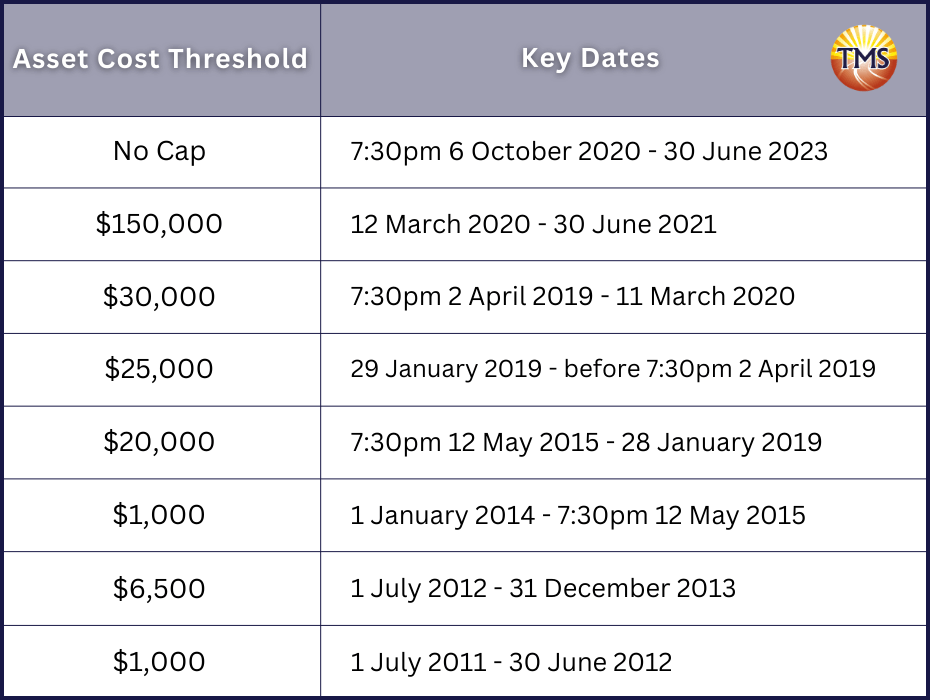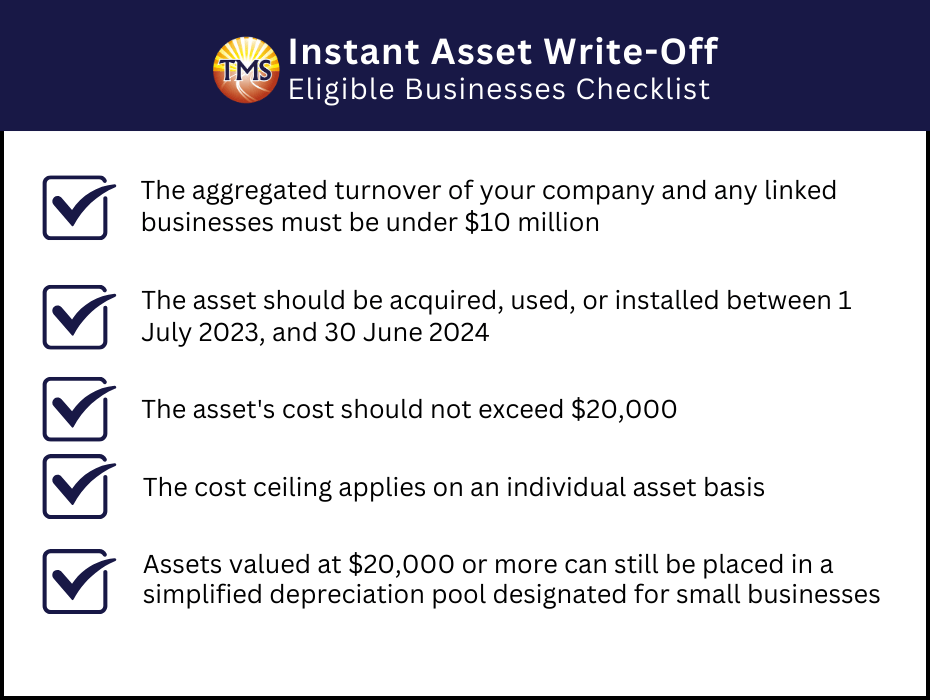Navigating the Shift from Temporary Full Expensing to Instant Asset Write-Off for the 2024 Financial Year
.
The impending expiration of the Temporary Full Expensing (TFE) at the close of the 2023 financial year means that businesses will revert to the Instant Asset Write Off (IAWO) system thereafter.
For companies looking to maximise their tax deductions, it’s essential to understand and follow the TFE guidelines, especially concerning existing eligible depreciating assets. These regulations permit businesses to fully deduct eligible depreciating assets during the financial year in which they are first put to taxable use, but this must be done before 30 June 2023. With this deadline in mind, companies must remain vigilant to fully leverage these tax advantages.
Simply finalising an asset’s purchase or even purchasing it by the given deadline isn’t enough. TFE, functioning on a per-asset model, requires each asset to meet specific eligibility criteria. Specifically, each asset has to be operational or installed and ready for its intended purpose within the set timeframe to qualify for full expensing.
Business entities, encompassing small enterprises and corporate taxpayers, with a turnover below a set limit should give careful consideration to this expensing incentive, especially in the context of existing eligible depreciating assets. It’s also important to be aware of the cost boundaries set for assets under the TFE rules. It’s worth noting that aspects like super contributions, the concessional contributions cap, and the financial year have significant bearings on this topic, and stakeholders should ensure that they’re well-informed about their implications.
Guidelines Effective from 1 July 2023
As of 1 July 2023, the approach to depreciating assets for tax purposes will undergo a modification. From that date, assets will need to be amortised over their useful lifespan instead of being immediately written off.
For small business entities that use the simplified depreciation method, the Instant Asset Write Off cap for the cost of assets will be adjusted back to $1,000. This is a departure from the previous ceiling of $20,000, which was implemented starting 12 May 2015 and had been subsequently extended and raised. Although there are plans to reset this threshold back to $20,000, the legislative process to formalise this adjustment remains incomplete.
Businesses that hadn’t previously opted for the general small business pool (either by choice or because they only recently met the small business entity criteria) might think about doing so for the 2023 financial year. This decision lets you consolidate the tax-adjusted values of qualified depreciating assets into the pool in 2023, granting them the chance to fully write off pool balances under $20,000 by the financial year’s end.
For the broader taxpayer base, the Standard Asset Write-Off will not be accessible from 1 July 2023 onward. Yet, assets priced below $1,000 can be directed to a low-value pool if the taxpayer elects this option. Business taxpayers are permitted to classify expenses up to $100 as revenue expenditures under PS LA 2003/8 and can deduct them entirely. On the other hand, non-business taxpayers, including salaried individuals, can lean on a legal provision permitting a full deduction for depreciating assets priced at $300 or below.
Understanding Temporary Full Expensing (TFE)
To qualify for the TFE benefit, a business should satisfy these conditions:
- Maintain an aggregated turnover of under $5 billion.
- Acquire and commence the use of (or install for readiness of use) the eligible new assets from 6 October 2020 7:30 pm AEDT through 30 June 2023.
In cases where a business doesn’t align with TFE specifications or is deemed ineligible, they might still qualify for the Instant Asset Write-Off mechanism. For this to apply, assets should have:
- Been procured by the end of December 2020.
- Been put into service or readied for use by 30 June 2021.
How Temporary Full Expensing works
Financial Year and Superannuation Factors
When Turnover Affects Deductions
What is the Immediate Asset Deduction?
This tax benefit is applicable on an asset-by-asset basis, encompassing both brand-new and second-hand assets. To qualify, these eligible depreciating assets must be acquired and installed ready for use within the same income year that the deduction is claimed. The cost of these eligible assets should also adhere to any defined cost threshold as outlined by the Australian Taxation Office (ATO).
While full expensing of depreciating assets presents a tax-saving avenue, it’s crucial for corporate tax entities to be aware of other financial obligations, like superannuation contributions. These contributions are dictated by various guidelines, including the Maximum Super Contribution Base (MSCB) and the concessional contributions cap. Understanding and following the rules and eligibility criteria stipulated by the Australian Taxation Office (ATO) for both Temporary Full Expensing (TFE) and superannuation is essential for both maximising benefits and remaining compliant.
Qualifying Businesses and Asset Write-Offs
- The aggregated turnover of your company and any linked businesses must be under $10 million.
- The asset should be acquired, used, or installed between 1 July 2023 and 30 June 2024.
- The asset’s cost should not exceed $20,000.
- The cost ceiling applies on an individual asset basis.
- Assets valued at $20,000 or more can still be placed in a simplified depreciation pool designated for small businesses.
Various contribution limits like the concessional contributions cap and Maximum Super Contribution Base (MSCB) also come into play, as regulated by the Australian Taxation Office (ATO). Monitoring these can help companies manage both tax deductions and super contributions efficiently.
Example: Immediate Asset Write-Off for Business and Personal Use Assets
For tax purposes, John assessed the eligible portion of the computer’s cost for the Immediate Asset Write-Off, which came to $5,440 (80% of $6,800). For the printer, the entire amount of $700 was eligible for the write-off. In his income tax return, John included the total eligible amount of $6,140 under Immediate Asset Write-Off.
As a sole proprietor, John should also be mindful of various superannuation-related contributions, including employer contributions, SG contributions, and after-tax contributions. These are subject to various caps and rules, such as the Maximum Super Contribution Base (MSCB) and the concessional contributions cap, as defined by the Australian Taxation Office (ATO) for the applicable financial year. It’s essential for John to consult with a professional to ensure that he stays within these limits and takes advantage of all available tax benefits.
Example: Depreciating Asset for the Hospitality Sector
In the hospitality industry, a variety of assets qualify for this type of tax deduction. For instance, kitchen appliances such as microwaves, ovens, and refrigerators, as well as coffee makers, fall under this category. Tech devices like laptops, desktop computers, point-of-sale terminals, and printers also qualify. In addition, furniture like chairs, tables, and couches are considered depreciating assets. Vehicles like cars, bikes, and delivery vans can also be included in this list, although they have specific price limits based on the financial year—for instance, $64,741 for the 2022/23 financial year and $68,108 for 2023/24.
While focusing on these tax-deductible assets, businesses should also be aware of other financial considerations like superannuation contributions. Whether it’s employer contributions, super guarantee contributions, or voluntary contributions, each has specific rules and limits. Terms like the Maximum Super Contribution Base, concessional contributions cap, and the superannuation guarantee are important to understand within the context of a company’s financial year to ensure compliance with the Australian Taxation Office guidelines.
What are the Limitations?
Special rules exist for proprietary software, but fees for third-party software like point-of-sale systems aren’t covered. While focusing on asset deductions, businesses should also note employer contributions and the concessional contributions cap, all monitored by the ATO for compliance within the financial year.
Where can small enterprises find assets that qualify for tax incentives?
Before making any significant investments, it’s imperative for businesses to validate whether an asset is eligible for tax deductions, such as the Instant Asset Write-Off or the Temporary Full Expensing (TFE) schemes.
The primary objective of these schemes, as outlined by the Australian Taxation Office, is to stimulate business investments and expansion. Their purpose is not just to cut down on tax contributions for the financial year. It’s essential to align purchases with current operational needs and future goals. Procuring large assets might have immediate effects on your financial situation, including cash flow, so these purchases should be made with due diligence.
Numerous vendors cater to the hospitality industry, providing equipment that fits the criteria for the Instant Asset Write-Off. Furthermore, businesses should be aware of the various rules associated with super contributions, such as employer contributions, concessional contributions cap, and the financial implications they might have for the business.
Restrictions or exclusions for Instant Asset Write-Off and Temporary Full Expensing schemes
The categories of assets that face these limitations include:
- Luxury vehicles, commonly referred to as “expensive” cars
- Real estate and other assets qualifying for capital works deductions
- Assets situated abroad
- Certain primary production assets, like fencing and water facilities, which may already be part of a separate instant write-off scheme
- Assets not employed for a taxable purpose in the business
Luxury Automobiles
This long-standing rule, carried over to the Temporary Full Expensing (TFE) scheme, serves to prevent businesses from using taxpayer funds to acquire extravagant luxury vehicles.
However, it’s essential to note that motor vehicles not classified as cars for tax purposes are exempt from the expensive car limit. This means that commercial vehicles like vans, buses, and trucks, when acquired and used for business purposes, can have their entire cost depreciated, regardless of their total value.
Moreover, certain larger utes can also be classified as commercial vehicles rather than cars if they possess a carrying capacity exceeding one ton. If a business invests in one of these utes, even if it exceeds the car limit in cost, it may still be eligible for a full write-off under the Temporary Full Expensing scheme.
Temporary Full Expensing (TFE) Rules for Business Assets
For instance, when a business acquires office furniture, it qualifies for TFE benefits. However, if an individual in an employment capacity buys the same office furniture, they are not eligible for TFE deductions.
In cases where an asset serves both business and personal purposes, any TFE deduction claimed must be proportionate. For example, if you purchase a computer for $2,500 and use it equally for business and personal use (50% each), you can only claim a TFE deduction of $1,250.
Please note that TFE rules are designed for eligible businesses to claim accelerated tax deductions on their eligible depreciating assets, allowing them to fully expense the cost of these assets. The eligibility criteria and specific rules are determined by the Australian Taxation Office, and it is important for corporate tax entities, small business entities, and other eligible business entities to adhere to these guidelines when claiming depreciation deductions.
Summary
Starting from 1 July 2023:
- Medium and large businesses won’t have an immediate deduction mechanism. However, they can still use PS LA 2003/8 for low-cost business assets, with a cost of up to $100, including GST (or $90.01 excluding GST).
- Small Business Enterprises (SBEs) will have the opportunity to benefit from the Instant Asset Write Off threshold, which will be temporarily increased to $20,000 for eligible depreciable assets (per asset) that are first put to use or installed and ready for use between 1 July 2023 and 30 June 2024.
- Assets with a cost of $20,000 or more will be added to the small business general use pool and will depreciate at a rate of 15% in the first income year, followed by 30% each year thereafter.
These changes reflect updates to the tax incentives and depreciation methods applicable to different business entities and asset costs, with a focus on temporary full expensing, instant asset write-off, and simplified depreciation rules.
Next Step is to Contact TMS Financials
Book a free financial health review to see the difference we can make in your financial future.
Disclaimer
Learn how Temporary Full Expensing can benefit your business
Schedule a FREE consultation with TMS Financials today to get personalised guidance
Related Articles

Minimising Capital Gains Tax on investment property guide
Minimising Capital Gains Tax on investment...

Division 7A compliance: Essential updates for business owners in 2025
Division 7A compliance: Essential updates for...

How to save FBT costs with your next Electric Vehicle
How to save FBT costs with your next Electric...
Contact Us
Tax Insights & Business Advice
Receive only the guidance that matters. Subscribe now for personalised tips and expert advice, directly suited for you and your business.





